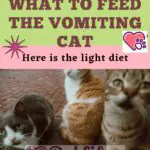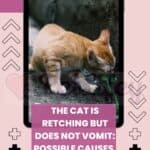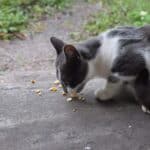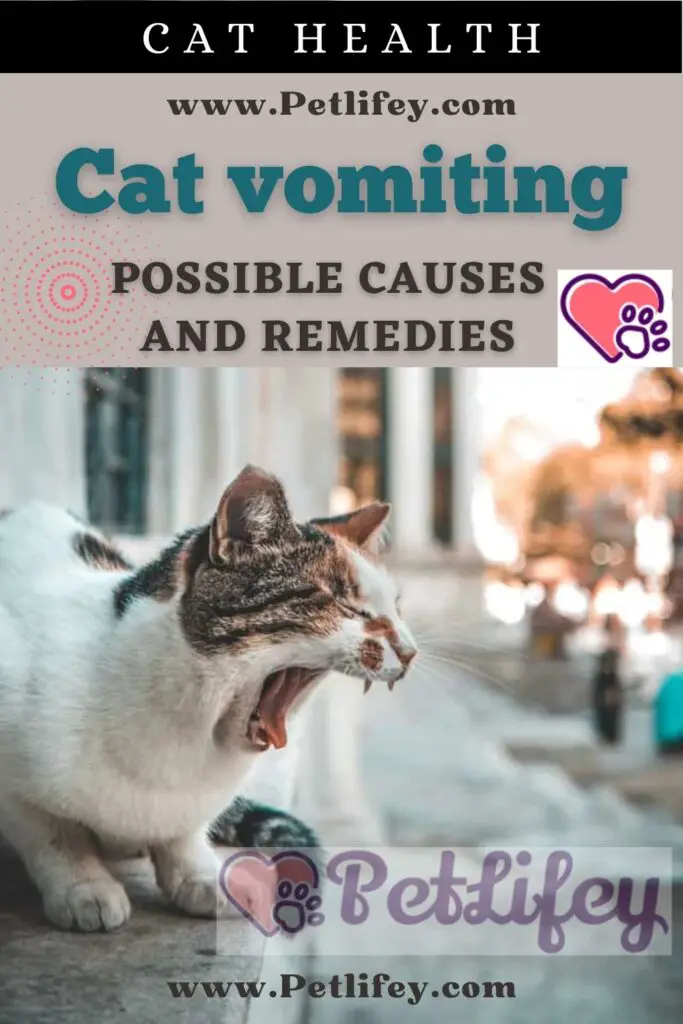
Is your cat suffering from vomiting and you don’t know why? Here’s what it might be doing, if you need to worry, and how to fix it.
Is your cat suffering from vomiting episodes or is it just a regurgitation? It is important to make this first distinction. How do you know that a cat is about to throw up? From the classic retches that precede the expulsion of organic material. It is necessary to evaluate how often it happens to him and what kind of expelled material it is. Here’s when to worry and what the owner can do in these cases to avoid the worst.
Cat vomiting or regurgitation?
For some it may be an unimportant distinction, but it is essential to recognize the two types. In fact there is a considerable difference between the first, also called emesis, and the second: it lies in the type of material expelled. In fact, in the case of vomiting from the cat’s mouth a gastrointestinal material comes out, while in the case of regurgitation what is expelled has always remained inside the mouth or has just reached the stomach and then follows the ‘reverse path’. Furthermore, vomiting is always preceded by retching, which apparently seem like uncontrollable attempts by the material that tends to come out.
If the cat is a puppy, the first episode of retching can be a shock both for him and for the owner who is not used to it: in fact the cat’s cry is also due to the fear of not knowing what is about to happen to him. Salivation increases and the tummy contracts, contributing to the expulsion of organic material: another difference with regurgitation is that in this case there is no nausea and there are no abdominal movements.
Another aspect to consider, although quite unpleasant, is the type of material expelled: if it is in fact vomiting it will be food already partially digested, on which the gastric juices had already begun to act . In the case of regurgitation, however, these are pieces of food or other present in the mouth or that had just touched the stomach.
Regurgitation could be a wake-up call for an esophageal pathology: it is better to consult the doctor’s opinion and explain how to deal with the situation.
Vomiting in cats: main causes
Here are the classic reasons that force the cat to expel ingested material. The very consistency of the expelled vomit will give us a fundamental indication of its cause. Here are the main ones.
Hairballs
We all know that cats vomit hairballs: this happens because the cat has the (good) habit of cleaning itself by licking its hair, that is, passing over it by passing its tongue over it. This one, equipped with a kind of rough tiny growths that function as ‘hooks’, collects the hair like a comb. Naturally, the hair accumulated in the mouth ends up in the stomach and the hair bales that are formed block the normal functioning of the cat’s digestive system. When are vomiting episodes more frequent than hairballs? During the moulting period, of course, when the cat is re-dressing.
Various objects
If it is not hair it is likely that the cat has ingested some object taking advantage of our inattention. It’s not just about the outdoor cat: even when the cat is indoors, the cat may find something interesting to ‘taste’. In fact, often these are waste materials, plastic objects, blades of grass and even more or less small insects and in some cases even residues of excrement (coprophagia is a rather widespread pathology). In addition to being irritating to the stomach walls, these objects can also be the cause of infections due to the action of parasites.
Greed
If the cat eats too much or too quickly, it could suffer from vomiting: if the food it ingests is more than the ‘capacity’ of the stomach it is likely to tend to reject it. It is equally likely that excessive physical activity immediately after a meal causes a gastro-intestinal disorder: on the other hand, running or making excessively strenuous movements also affects our digestion.
Catnip
The magical catnip is often used precisely for the purpose of stimulating vomiting: if we notice that the cat has eaten too much, it is good to give it an irresistible tub or jar of catnip. In fact, it will help the cat to get rid of excess food.
Other causes of vomiting
If it is not one of the three reasons listed above, it is likely that the cat is suffering from viral infections, renal or hepatic insufficiency, pancreatitis; or he may have been a victim of chemical poisoning or an allergy to some medications. It is equally likely that it is allergies or intolerances to some types of food. If the vomiting is accompanied by evident dehydration, lethargy, traces of blood in the vomit, weight loss and a sense of general exhaustion, it is good to call the expert into question.
Vomiting of the cat: the alarm bells
One of the first signs that should not be underestimated is the frequency with which these episodes occur. If it is not an isolated case but it happens quite often it is worth contacting a veterinarian. Another detail not to be underestimated is the analysis of the expelled material: based on its consistency and residues that still remain in the expelled mass, it will be possible to understand if it was spoiled food, grass, hair. In some cases it could be infectious enteritis, a pathology that irritates the walls of the cat’s stomach, but which is not the case to be explored here.
What must absolutely push us to call for help is the presence of blood in the vomit: it signals bleeding between the oral cavity and the upper small intestine. Although it is a dark red, almost brown colored material, it is likely that it is congealed blood and therefore indicates an old bleeding that has already been digested.
When the cat, on the other hand, expels material that resembles feces in appearance and smell, it is likely that it suffers from intestinal obstruction or peritonitis. If it is not such a pathology then the cause is to be found in a blow to the abdomen, an abrupt and important trauma to which the cat was the victim. Also in this case, the call to the veterinarian is urgent.
If your cat’s vomiting or regurgitation is accompanied by other symptoms, don’t hesitate to contact your vet. These are weakness, difficulty or reluctance to move, diarrhea, fever, pain when we touch their tummy.
Vomiting of the cat: we pay attention to its appearance
The actual vomit that has a thick and grainy consistency is often preceded by a white foam or white vomit. Most of the time it heralds the arrival of the actual vomit. When it comes out of the mouth it has an oblong shape and its consistency depends on what the cat had eaten (the very color of the treats can give the color to the expelled vomit).
When the cat vomits ‘bullet’ it refers to a material expelled suddenly, with strong impetuosity, and with such power to reach considerable distances. When the cat vomits in small jets it is likely that it suffers from a total blockage of the upper gastrointestinal system. What could have caused it? Objects, hairballs, but also tumors and strictures. Unfortunately, the causes may also include brain pathologies, which increase the intracranial pressure of the nervous system, i.e. brain tumor, encephalitis and blood clots.
Vomiting of the cat: what can we do
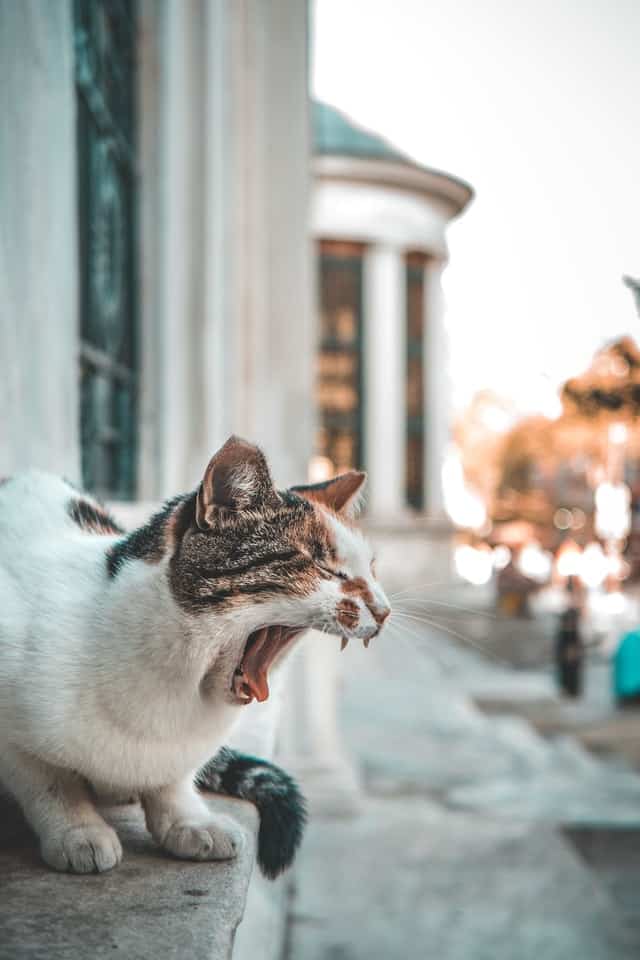
They seem useless details and yet changing our cat’s diet could be a great starting point. The ideal diet could be enriched with easily digestible foods, such as chicken or turkey. To exclude that the cause of vomiting is a food intolerance, it will be necessary to always feed the same food in his diet and understand what effect it has on him.
Even the way he eats can be changed: it is better if the owner himself administers the food in small bites. An idea to ‘slow down’ the pace could be to buy food locked in some semi-closed supports that the cat will have to work out to open to eat the contents.
The bowl must have edges that are neither too high nor too low: in fact, the difficulty of food in descending towards the esophagus could create problems and cause vomiting. Naturally, in the house we make objects that could be ingested disappear from its reach.
When the cat vomits, it is not necessary to give it a drink for the next two hours, just to avoid other episodes of this kind. The water should be given in small doses and then gradually move on to lighter and more digestible foods. This does not mean not to drink it, but to do it gradually: with the vomiting the cat will be dehydrated and will have to replenish the lost mineral salts.


